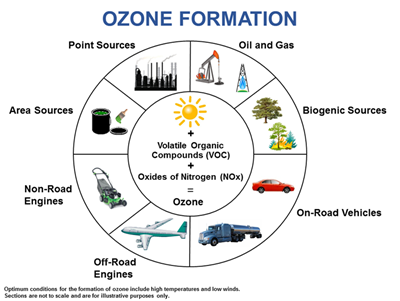Ozone is a gas formed in the
 atmosphere when three atoms of oxygen combine. Naturally occurring ozone is found high in the stratosphere surrounding the earth and in ground level ambient air.
atmosphere when three atoms of oxygen combine. Naturally occurring ozone is found high in the stratosphere surrounding the earth and in ground level ambient air.
Where does it come from?
Stratospheric Ozone - forms high in the atmosphere when intense sunlight causes oxygen molecules (O2) to break up and re-form as ozone molecules (O3). Also known as "good ozone," it shields people, trees, crops, property, and microorganisms from the harmful effects of the sun's ultraviolet light.
Ground Level Ozone - regularly referred to as “bad ozone” forms when nitrogen oxides (NOX) and volatile organic compounds (VOC) emitted from human and natural sources react in the presence of sunlight. Click on the ozone formation image above for more information.
How is it harmful?
Breathing ozone can trigger a variety of health problems including chest pain, coughing, throat irritation, and congestion. It can worsen bronchitis, emphysema, and asthma. Ground level ozone also can reduce lung function and inflame the linings of the lungs. Repeated exposure may permanently scar lung tissue. People with lung disease, children, older adults, and people who are active outdoors may be particularly sensitive to ozone.
In addition, failure to meet federal standards for air quality could result in additional emission-control requirements that will unfavorably affect local businesses. It may also result in a freeze on federally funded transportation projects, costing the region upward of billions of dollars in lost transportation funding. This would ultimately affect jobs in the region and cost money in lost productivity due to traffic congestion delays. See the links below for complete details on ozone and the region's ozone status.
What's being done to help?
Federal Level
The Environmental Protection Agency (EPA) has currently set the primary and secondary 2015 ozone NAAQS at less than or equal to 70 parts per billion. A region's design value (annual fourth-highest daily maximum 8-hour concentration, averaged over three years) must meet this standard, or the EPA designates the area as nonattainment for ozone. The Clean Air Act Amendments of 1990 define various classification levels for ozone nonattainment, each requiring different emission reduction control strategies, transportation conformity and State Implementation Plans to decrease ozone pollution. These standards are subject periodic review as updated scientific information and modeling procedures are developed to determine the long-term health effects of ground level ozone.
Local Level
The 10-county region of North Central Texas is currently designated as moderate nonattainment for the 2008 ozone NAAQS and marginal nonattainment for the 2015 ozone NAAQS. Previously, the nine-county region was designated as serious nonattainment for the 1997 ozone NAAQS; however, the EPA revoked this standard on April 6, 2015. Although the standard is revoked, the nine-county region, per the Clean Air Act, continues to be held to anti-backsliding requirements. There are various programs in place to help decrease ground level ozone in the North Central Texas region. To learn more about these programs, click on the following links:
Additional Information
For detailed information on ozone nonattainment designations and rule implementation, visit the EPA's Ozone web page.
For more information, please contact Nick Van Haasen.